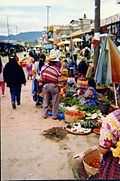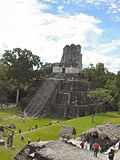Spanish 1/Chapter 7 (Health)
< Spanish 1Chapter 7 (Health)
Food terms
- cena - dinner
- bistec - beef
- carne - meat
- pescado - fish
- pollo - chicken
- cebolla - onion
- guisantes - peas
- judías verdes - green beans
- lechuga - lettuce
- papas - potatoes
- tomates - tomatoes
- uvas - grapes
- zanahorias - carrots
Food pyramid examples
- arroz - rice
- cereales - grains
- espaguetis - spaghetti
- grasas - fats
- mantequilla - butter
- helado - ice cream
- pasteles - pastries
- bebidas - beverages
Useful phrases
- Tengo hambre. - I'm hungry.
- Tengo sed. - I'm thirsty.
Verbs and health-related phrases
- caminar - to walk
- hacer ejercicio - to exercise
- hago - I do
- haces - you do
- levantar pesas - to lift weights
- para la salud - for one's health
- para mantener la salud - to maintain one's health
Words to express thought
- prefiero - I prefer
- prefieres - you prefer
- deber - must
- creer - to think
- Creo que ... - I think ...
- Creo que sí. - I think so.
- Creo que no. - I don't think so.
- Estoy de acuerdo. - I agree.
- No estoy de acuerdo. - I don't agree.
To say a question and answer
- ¿Por qué? - Why?
- porque - because
Words to describe something
- algo - something
- muchos(as) - many
- todos(as) - all
- horrible - horrible
- malo(a) - bad
- sabroso(a) - tasty, flavorful
Other words
- cada día - everyday
Grammar: Singular & Plural Adjectives
In Spanish, the adjective always comes after the noun and has to agree with the number of things being described.
- sabroso/sabrosos - tasty, flavorful (masculine; singular/plural)
- popular/populares - popular (masculine; singular/plural)
- sabrosa/sabrosas - tasty, flavorful (feminine; singular/plural)
- popular/populares - popular (feminine; singular/plural)
Example: La cereza es sabrosa. - singular
Las cerezas son sabrosas. - plural
Ser (to be)
The verb ser in Spanish also means "to be." Ser vs estar is one of the most difficult things to learn for a native English speaker learning Spanish. "Estar" is used to tell the geographic location, state or condition, most idiomatic expressions, and progressive tenses. Examples of when ser is used are: time, place of origin, essential characteristic, taking place, occupation, nationally, affiliation, possession, qualities, and relationship.
- soy - I am
- eres - you are (singular)
- es - he/she is
- somos - we are
- sois - you are (plural)
- son - they are
Note: Remember that usted (Ud.) and ustedes (Uds.) are always conjugated in 3rd person form.
Etc.
- soda - casual restaurant (Costa Rica)
Note: Soda is also used rarely in the United States and Panama to refer to a casual Costa Rican restaurant.
Vocabulario adicional
- apio - celery
- brócoli - broccoli
- calabaza - pumpkin
- champiñón - mushroom
- col - cabbage
- coliflor - califlower
- espárragos - asparagus
- espinacas - spinach
- maíz - corn
- pepino - cucumber
- verdura - vegetable
- chuleta de cerdo - pork chop
- cordero - lamb
- ternera - veal
- condimento - condiment
- salsa de tomate - ketchup
- mostaza - mustard
- mayonesa - mayonaise
- salsa tártara - tartar sauce
- salsa de soja/soya - soy sauce
- fideos - noodles
Cultural Insight (Meals in Spanish-speaking counries)
In Spanish-speaking countries, mealtimes are more relaxed than in the United States. People will usually sit down with friends and family and socialize. Drive-thrus in restaurants are less common than in other countries and many cars don't have cupholders.
Country Focus (Guatemala)

Guatemala (Spanish: Guatemala) is a country in Central America bordered by Mexico to the north and west, the Pacific Ocean to the southwest, Belize and the Caribbean Sea to the northeast, and Honduras and El Salvador to the southeast.
A representative democracy, its capital is Guatemala City. The nation has been stable since 1996 and has been in a state of continuous development and economic growth. Guatemala's abundance of biologically significant and unique ecosystems contribute to Mesoamerica's designation as a biodiversity hotspot.

The Classic period of Mesoamerican civilization corresponds to the height of the Maya civilization, and is represented by countless sites throughout Guatemala, although the largest concentration is in Petén. This period is characterized by heavy city-building, the development of independent city-states, and contact with other Mesoamerican cultures. This lasted until

around 900 AD, when the Classic Maya civilization collapsed. The Maya abandoned many of the cities of the central lowlands or were killed off by a drought-induced famine. Scientists debate the cause of the Classic Maya Collapse, but gaining currency is the Drought Theory discovered by physical scientists studying lakebeds, ancient pollen, and other tangible evidence.

Guatemalan culture is mainly expressed through literature, music, and art.
Factbox:
-Official Language: Spanish
-Other Languages: Quiché, Mayan languages
-Capital: Guatemala City (Ciudad de Guatemala)
-Government: Democracy
-Area: 108,889 sq km (42,042 sq mi) (108th)
-Population: 13,276,517 (July 2009) (68th)
-Religion: Christianity (Catholic 50%, Protestant 40%) 90%, Traditional beliefs 1%, Buddhism 0.1%, other (Non-religious, Islam, Judaism) 8.9%
-Human Development: 0.704 (122nd, MEDIUM)
-Independence: September 15, 1821
-Currency: Quetzal